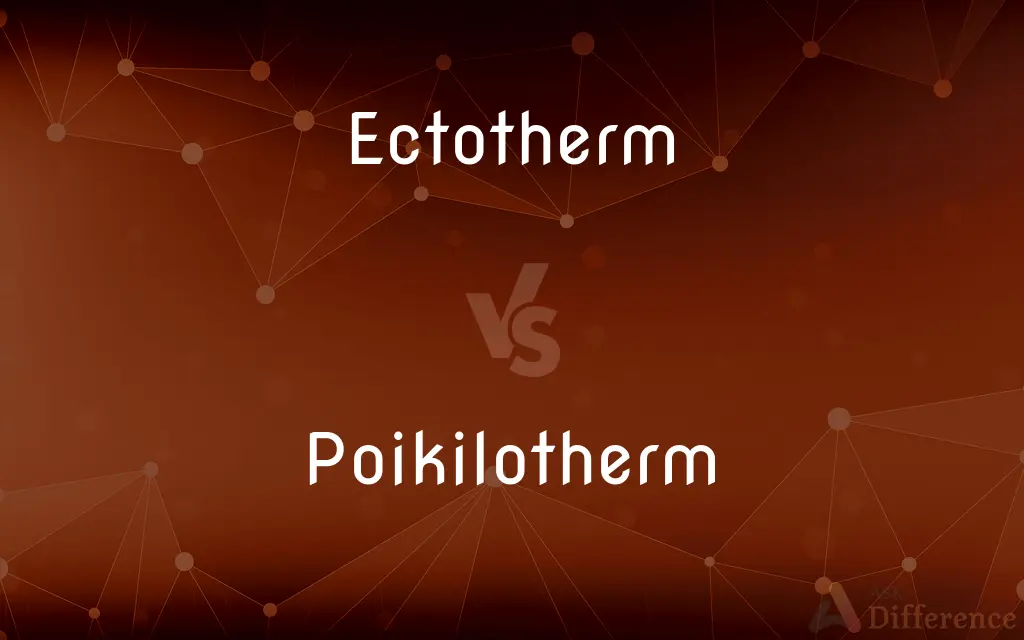Ectotherm vs. Poikilotherm — What's the Difference?
By Maham Liaqat & Urooj Arif — Updated on March 25, 2024
Ectotherms regulate body temperature through external sources, while poikilotherms have variable body temperatures dependent on environmental conditions.

Difference Between Ectotherm and Poikilotherm
Table of Contents
ADVERTISEMENT
Key Differences
Ectotherms are organisms that rely on external environmental conditions to regulate their body temperature. They absorb heat from their surroundings, meaning they become more active in warmer conditions and less so in cooler ones. This includes many reptiles, amphibians, and fish. Poikilotherms, on the other hand, are characterized by their body temperature varying with the ambient temperature. While all poikilotherms are ectotherms, not all ectotherms are poikilotherms. This distinction is crucial because some ectotherms can maintain a relatively stable body temperature through behavioral adaptations, such as basking in the sun or seeking shade.
In terms of metabolic rate, ectotherms typically have a lower metabolic rate compared to endotherms, as they do not need to burn calories to generate body heat. However, the metabolic rate of poikilotherms can vary widely depending on the environmental temperature. When it's warmer, their metabolism speeds up, and it slows down when the temperature drops. This adaptability allows poikilotherms to thrive in environments with fluctuating temperatures, though it also means they can be less active in cooler conditions.
Behavioral adaptations play a significant role in how ectotherms and poikilotherms manage their body temperature. Ectotherms may exhibit behaviors like sunning themselves to increase their body temperature or moving to cooler areas to decrease it. Poikilotherms, due to their body temperature fluctuating with the environment, may employ more drastic behavioral strategies to cope with extreme temperatures, such as hibernation or estivation.
The ecological niches occupied by ectotherms and poikilotherms differ due to their thermoregulatory strategies. Ectotherms are often found in environments where they can easily regulate their temperature through external means, whereas poikilotherms can occupy a broader range of habitats, including those with significant temperature variations. This flexibility in habitat is balanced by the need to avoid extreme conditions that could impair their physiological functions.
The distinction between ectotherms and poikilotherms highlights the diversity of life's strategies for dealing with the challenge of temperature regulation. While ectotherms rely on external heat sources, poikilotherms' body temperatures vary more directly with their environment, showcasing the varied adaptations organisms have developed to survive and thrive in their specific ecological niches.
ADVERTISEMENT
Comparison Chart
Temperature Control
External environmental conditions
Body temperature varies with ambient conditions
Metabolic Rate
Generally lower, varies with temperature
Varies widely with environmental temperature
Behavioral Adaptations
May include sunning or seeking shade
Can include hibernation or estivation
Ecological Niches
Environments with accessible means to regulate temperature
Broad range, including areas with significant temperature variations
Examples
Reptiles, amphibians, fish
Many reptiles, amphibians, and some fish
Compare with Definitions
Ectotherm
Relies on external heat sources.
A snake basks in the sun to increase its body temperature.
Poikilotherm
Faces challenges in extreme cold or heat.
A snail becomes dormant during dry or cold seasons to conserve moisture and energy.
Ectotherm
Lower metabolic rate in cool environments.
A frog becomes less active to conserve energy when it's cold.
Poikilotherm
Metabolic rate changes with ambient temperature.
A grasshopper's activity level increases with warmer temperatures.
Ectotherm
Predominantly found in warmer climates.
Tropical fish are ectotherms thriving in warm waters.
Poikilotherm
Utilizes behavioral adaptations for extreme temperatures.
A bear enters hibernation to survive the winter.
Ectotherm
Utilizes the environment for thermoregulation.
A turtle buries itself in mud to stay cool.
Poikilotherm
Can inhabit a range of thermal environments.
Desert reptiles are poikilotherms that withstand high temperature variations.
Ectotherm
Can maintain more stable temperatures behaviorally.
A lizard moves between sun and shade to regulate its temperature.
Poikilotherm
Body temperature varies with the environment.
The temperature of a goldfish fluctuates with the water temperature.
Ectotherm
An ectotherm (from the Greek ἐκτός (ektós) "outside" and θερμός (thermós) "heat") is an organism in which internal physiological sources of heat are of relatively small or of quite negligible importance in controlling body temperature. Such organisms (for example frogs) rely on environmental heat sources, which permit them to operate at very economical metabolic rates.Some of these animals live in environments where temperatures are practically constant, as is typical of regions of the abyssal ocean and hence can be regarded as homeothermic ectotherms.
Poikilotherm
A poikilotherm () is an animal whose internal temperature varies considerably. Poikilotherms have to survive and adapt to environmental stress.
Ectotherm
An organism that depends on external sources for its body heat.
Poikilotherm
An organism, such as a fish or reptile, having a body temperature that varies with the temperature of its surroundings.
Ectotherm
(biology) An animal, such as an amphibian, fish, reptile, or arthropod, which has a limited ability to regulate its body temperature and whose body temperature thus depends on the ambient temperature.
Poikilotherm
An animal whose body temperature varies with the temperature of its surroundings; any animal except birds and mammals
Ectotherm
An animal whose body temperature varies with the temperature of its surroundings; any animal except birds and mammals
Common Curiosities
What defines an ectotherm?
An ectotherm is an organism that regulates its body temperature through external sources, such as sunlight or the ambient temperature of its surroundings.
Why do ectotherms have a lower metabolic rate?
Ectotherms have a lower metabolic rate because they do not need to expend energy to generate heat internally, relying instead on external heat sources.
Can an ectotherm also be a poikilotherm?
Yes, all poikilotherms are ectotherms, but not all ectotherms are poikilotherms, as some ectotherms can maintain more stable body temperatures through behavioral means.
How do behavioral adaptations help ectotherms and poikilotherms?
Behavioral adaptations, such as basking or seeking shade, help ectotherms and poikilotherms manage their body temperature in response to environmental changes.
What is the advantage of being a poikilotherm?
The advantage of being a poikilotherm includes the ability to thrive in a wide range of temperatures by adjusting metabolic rate and behavior according to environmental conditions.
Can poikilotherms be found in polar regions?
Few poikilotherms are found in polar regions, as these areas require specific adaptations to survive the extreme cold.
How do poikilotherms regulate their body temperature?
Poikilotherms’ body temperatures vary with the environmental conditions, employing behavioral strategies to cope with temperature changes.
How do ectotherms survive in cold environments?
Ectotherms may hibernate or seek microenvironments that provide warmth, such as underground burrows, to survive in cold conditions.
What challenges do poikilotherms face in varying temperatures?
Poikilotherms can face challenges in extreme temperatures that may limit their activity or require specific adaptations like hibernation to survive.
Are all reptiles ectotherms?
Yes, all reptiles are ectotherms, but their ability to regulate their body temperature can vary, with some being poikilothermic.
Do ectotherms eat more in warmer temperatures?
Yes, ectotherms typically eat more in warmer temperatures due to an increased metabolic rate, which requires more energy.
What is the difference in habitat preference between ectotherms and poikilotherms?
Ectotherms prefer environments where they can easily regulate their temperature externally, while poikilotherms can adapt to a broader range of thermal conditions due to their variable metabolic rate.
Share Your Discovery

Previous Comparison
Anywhere vs. Anyplace
Next Comparison
Cherish vs. TreasureAuthor Spotlight
Written by
Maham LiaqatCo-written by
Urooj ArifUrooj is a skilled content writer at Ask Difference, known for her exceptional ability to simplify complex topics into engaging and informative content. With a passion for research and a flair for clear, concise writing, she consistently delivers articles that resonate with our diverse audience.
















































